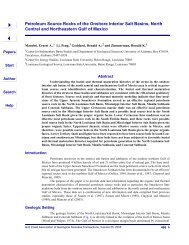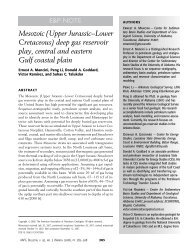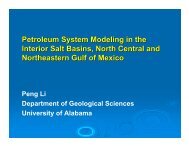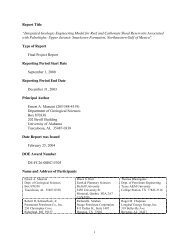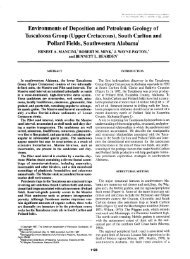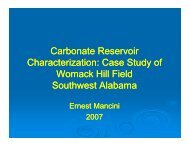Part 4 - Berg - Hughes Center
Part 4 - Berg - Hughes Center
Part 4 - Berg - Hughes Center
You also want an ePaper? Increase the reach of your titles
YUMPU automatically turns print PDFs into web optimized ePapers that Google loves.
generation (Table 4). The following characterization of the Bossier shale beds is based on<br />
the geological studies (Tables 5-8 and Figs. 333-341) by Don Goddard and Marty Horn at<br />
LSU and geochemical analyses (Table 9 and Figs. 342-348) by Suhas Talukdar with<br />
Baseline Resolution, Inc. The Bossier shale beds are thermally mature and represent<br />
petroleum source rocks that generated and potentially expelled mostly gas and some oil.<br />
These shale beds at their present maturity level have mostly low to moderate total organic<br />
carbon contents and Type III kerogen. Original kerogen types in the immature stage, as<br />
assessed by kerogen petrography, were mainly gas-prone Type III and some oil and gas<br />
prone Type II/III. The principal macerals are partly oxidized, unstructured amorphous<br />
organic matter (liptinite) and vitrinite in varying proportions. Amorphous material was<br />
derived from degraded marine algal and humic matter (higher plant material). Visual<br />
kerogen data support the predominantly gas prone nature of the source rocks. Vitrinite<br />
reflectance (Ro) values (0.94 % to 2.62%) and thermal alteration indices (TAI) (2 + to 3 + )<br />
suggest that these source rocks entered the late oil window to main gas maturity window<br />
and thus have generated mostly gas with some oil. Thin section petrography of<br />
geochemically analyzed intervals documents the following rock types: muddy fine-<br />
grained sandstone, laminated fine-grained sandstone, sandy mudstone, and silty<br />
mudstone. These combined analytical results indicate that abundant woody organic<br />
material of continental origin was deposited in offshore areas in association with fine<br />
siliciclastic sediments in a marine prodelta environment during the Late Jurassic to Early<br />
Cretaceous. The thickness and widespread deposition of predominantly gas-prone source<br />
rocks within this basin and their high thermal maturity led to potential sourcing of mainly<br />
394




